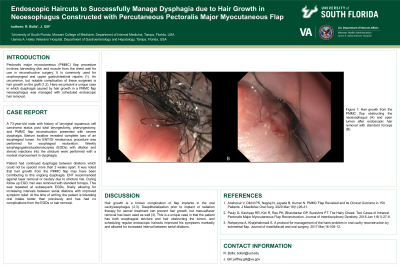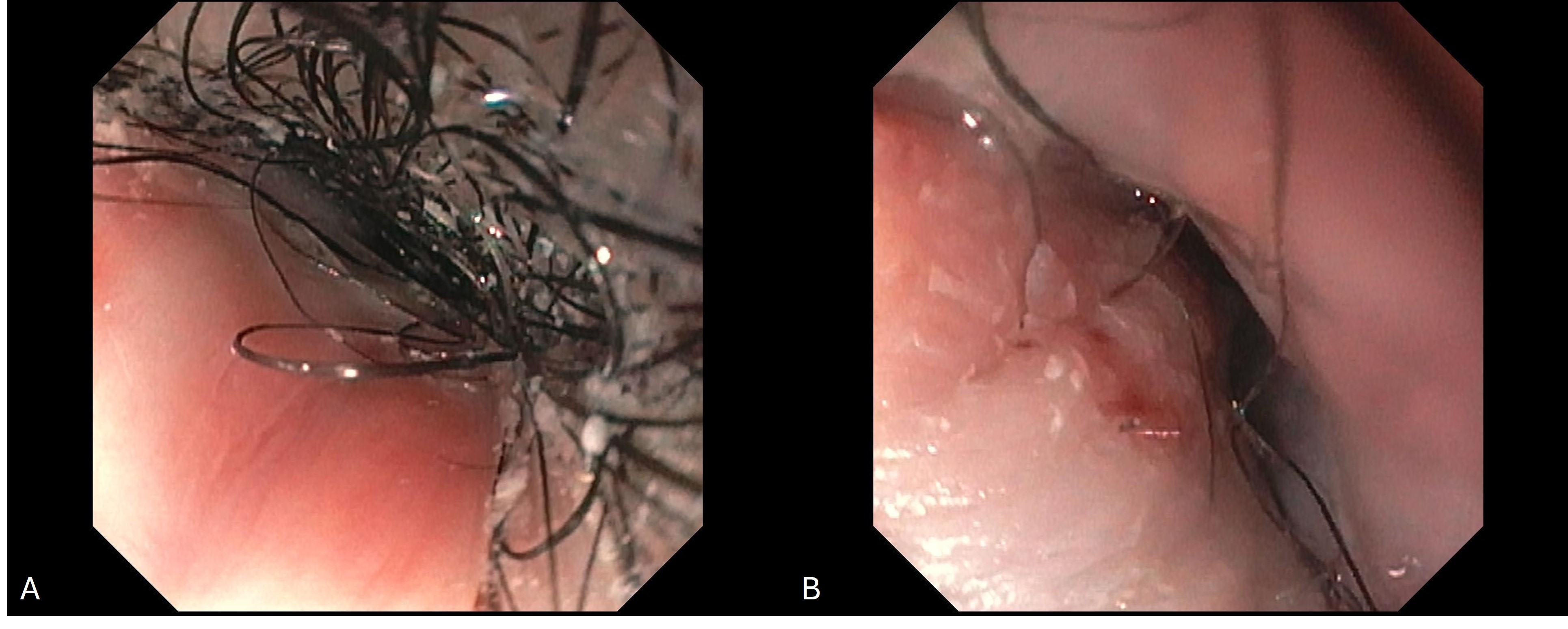Monday Poster Session
Category: Esophagus
P2290 - Endoscopic Haircuts Successfully Manage Dysphagia due to Hair Growth in Neoesophagus Constructed With Percutaneous Pectoralis Major Myocutaneous Flap
Monday, October 28, 2024
10:30 AM - 4:00 PM ET
Location: Exhibit Hall E

Has Audio
- RB
Rishi Bolla, MD
University of South Florida Morsani College of Medicine
Tampa, FL
Presenting Author(s)
Rishi Bolla, MD1, Jeffrey Gill, MD2
1University of South Florida Morsani College of Medicine, Tampa, FL; 2University of South Florida, James A. Haley VA Hospital, Tampa, FL
Introduction: Pectoralis major myocutaneous (PMMC) flap procedure involves harvesting skin and muscle from the chest wall for use in reconstructive surgery. It is commonly used for oropharyngeal and upper gastrointestinal repairs (1). An uncommon, but notable complication of these surgeries is hair growth on the graft (1,2). Here we present a unique case in which dysphagia caused by hair growth in a PMMC flap neoesophagus was managed with scheduled endoscopic hair removal.
Case Description/Methods:
A 73-year-old male with history of laryngeal squamous cell carcinoma status post total laryngectomy, pharyngectomy, and PMMC flap reconstruction presented with severe dysphagia. Barium swallow revealed complete loss of an esophageal lumen. An ENT/GI rendezvous procedure was performed for esophageal restoration. Weekly esophagogastroduodenoscopies (EGDs) with dilation and steroid injections into the stricture were performed with a modest improvement in dysphagia.
Patient had continued dysphagia between dilations which could not be spaced more than 2 weeks apart. It was noted that hair growth from the PMMC flap may have been contributing to this ongoing dysphagia. ENT recommended against laser removal or cautery due to stricture risk. During follow up EGD, hair was removed with standard forceps. This was repeated at subsequent EGDs, finally allowing for increasing intervals between serial dilations with improved symptom relief. At the time of writing, the patient is tolerating oral intake better than previously and has had no complications from the EGDs or hair removal.
Discussion: Hair growth is a known complication of flap implants in the oral cavity/esophagus (2,3). Deepithelialization prior to implant or radiation therapy for cancer treatment can prevent hair growth, but manual/laser removal has been used as well (3). This is a unique case in that the patient has both esophageal stricture and hair obstructing the lumen, and scheduling regular endoscopic haircuts improved his symptoms markedly and allowed for increased interval between serial dilations.
References
1. Anehosur et al. PMMC flap revisited and its clinical outcome in 150 patients. J Maxillofac Oral Surg. 2020 Mar;19:26-31.
2. Pauly et al. The Hairy Cheek: Two Cases of Intraoral Pectoralis Major Myocutaneous Flap Reconstruction. Journal of Interdisciplinary Dentistry. 2018 1;8(1):27-9.
3. Rahpeyma et al. A Protocol for Management of the Hairs Problem in Oral Cavity Reconstruction by Submental Flap. J Maxillofac Oral Surg. 2017;16(1):108-112.

Disclosures:
Rishi Bolla, MD1, Jeffrey Gill, MD2. P2290 - Endoscopic Haircuts Successfully Manage Dysphagia due to Hair Growth in Neoesophagus Constructed With Percutaneous Pectoralis Major Myocutaneous Flap, ACG 2024 Annual Scientific Meeting Abstracts. Philadelphia, PA: American College of Gastroenterology.
1University of South Florida Morsani College of Medicine, Tampa, FL; 2University of South Florida, James A. Haley VA Hospital, Tampa, FL
Introduction: Pectoralis major myocutaneous (PMMC) flap procedure involves harvesting skin and muscle from the chest wall for use in reconstructive surgery. It is commonly used for oropharyngeal and upper gastrointestinal repairs (1). An uncommon, but notable complication of these surgeries is hair growth on the graft (1,2). Here we present a unique case in which dysphagia caused by hair growth in a PMMC flap neoesophagus was managed with scheduled endoscopic hair removal.
Case Description/Methods:
A 73-year-old male with history of laryngeal squamous cell carcinoma status post total laryngectomy, pharyngectomy, and PMMC flap reconstruction presented with severe dysphagia. Barium swallow revealed complete loss of an esophageal lumen. An ENT/GI rendezvous procedure was performed for esophageal restoration. Weekly esophagogastroduodenoscopies (EGDs) with dilation and steroid injections into the stricture were performed with a modest improvement in dysphagia.
Patient had continued dysphagia between dilations which could not be spaced more than 2 weeks apart. It was noted that hair growth from the PMMC flap may have been contributing to this ongoing dysphagia. ENT recommended against laser removal or cautery due to stricture risk. During follow up EGD, hair was removed with standard forceps. This was repeated at subsequent EGDs, finally allowing for increasing intervals between serial dilations with improved symptom relief. At the time of writing, the patient is tolerating oral intake better than previously and has had no complications from the EGDs or hair removal.
Discussion: Hair growth is a known complication of flap implants in the oral cavity/esophagus (2,3). Deepithelialization prior to implant or radiation therapy for cancer treatment can prevent hair growth, but manual/laser removal has been used as well (3). This is a unique case in that the patient has both esophageal stricture and hair obstructing the lumen, and scheduling regular endoscopic haircuts improved his symptoms markedly and allowed for increased interval between serial dilations.
References
1. Anehosur et al. PMMC flap revisited and its clinical outcome in 150 patients. J Maxillofac Oral Surg. 2020 Mar;19:26-31.
2. Pauly et al. The Hairy Cheek: Two Cases of Intraoral Pectoralis Major Myocutaneous Flap Reconstruction. Journal of Interdisciplinary Dentistry. 2018 1;8(1):27-9.
3. Rahpeyma et al. A Protocol for Management of the Hairs Problem in Oral Cavity Reconstruction by Submental Flap. J Maxillofac Oral Surg. 2017;16(1):108-112.

Figure: Figure 1: Hair growth from the PMMC flap obstructing the neoesophagus (A) and open lumen after endoscopic hair removal with standard forceps (B).
Disclosures:
Rishi Bolla indicated no relevant financial relationships.
Jeffrey Gill indicated no relevant financial relationships.
Rishi Bolla, MD1, Jeffrey Gill, MD2. P2290 - Endoscopic Haircuts Successfully Manage Dysphagia due to Hair Growth in Neoesophagus Constructed With Percutaneous Pectoralis Major Myocutaneous Flap, ACG 2024 Annual Scientific Meeting Abstracts. Philadelphia, PA: American College of Gastroenterology.

